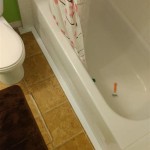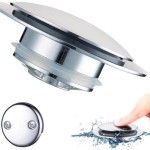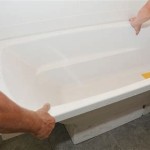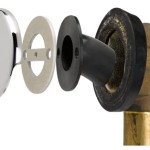Painting Fiberglass Bathtubs: A Comprehensive Guide
Fiberglass bathtubs, renowned for their lightweight construction, durability, and affordability, are a common fixture in many bathrooms. However, over time, these tubs can become stained, faded, or simply outdated, detracting from the overall aesthetic of the bathroom. Instead of incurring the significant expense and disruption associated with replacing the entire tub, painting the fiberglass surface offers a cost-effective and less invasive solution. This article provides a detailed guide on how to successfully paint a fiberglass bathtub, covering essential preparation steps, material selection, the painting process itself, and necessary post-painting care.
Successfully painting a fiberglass bathtub involves more than simply applying a coat of paint. It requires meticulous surface preparation, the use of specialized coatings formulated for such surfaces, and adherence to proper application techniques. Deviations from these best practices can result in premature peeling, chipping, or blistering, negating the time and effort invested in the project. Understanding each stage of the process is crucial for achieving a durable and visually appealing finish.
Key Point 1: Thorough Preparation is Paramount
The longevity and quality of the painted finish are directly proportional to the thoroughness of the surface preparation. This stage involves cleaning, repairing, and etching the fiberglass surface to ensure optimal paint adhesion. Neglecting any of these steps can compromise the integrity of the final result.
Cleaning: The first step is to remove all traces of soap scum, mildew, body oils, and other contaminants from the bathtub surface. Abrasive bathroom cleaners containing bleach are effective for this purpose. Apply the cleaner liberally, allow it to dwell for the recommended time, and then scrub vigorously with a non-scratch scouring pad or brush. Rinse thoroughly with clean water to remove all cleaner residues. Stubborn stains may require repeated applications or the use of specialized stain removers designed for fiberglass.
Repairing: Inspect the bathtub surface for any chips, cracks, or other imperfections. Minor chips can be filled with a two-part epoxy filler specifically designed for fiberglass repair. Thoroughly clean the damaged area, mix the epoxy according to the manufacturer's instructions, and apply it to the chip, filling it completely. Allow the epoxy to cure fully, then sand it smooth using fine-grit sandpaper (220-grit followed by 400-grit) to blend it seamlessly with the surrounding surface. For larger cracks or more extensive damage, consult a professional fiberglass repair technician.
Etching: Fiberglass surfaces are inherently smooth, making it difficult for paint to adhere properly. Etching the surface creates microscopic irregularities, providing the paint with a better grip. This is typically achieved using an etching solution specifically designed for fiberglass. Follow the manufacturer's instructions carefully when applying the etching solution, ensuring even coverage over the entire bathtub surface. Allow the solution to dwell for the recommended time, then rinse thoroughly with clean water. The surface should now feel slightly rough to the touch.
Masking: Protect surrounding areas, such as tiles, fixtures, and plumbing, with painter's tape and plastic sheeting. Pay particular attention to areas where the bathtub meets the wall or floor. Ensure the tape is applied firmly to create a tight seal, preventing paint from seeping underneath.
Key Point 2: Selecting the Right Materials
Choosing the appropriate primer and paint is crucial for achieving a durable and long-lasting finish on a fiberglass bathtub. Traditional paints and primers are not suitable for this application due to their poor adhesion and susceptibility to water damage. Specially formulated coatings are necessary to withstand the harsh environment of a bathroom.
Primer: An epoxy primer is highly recommended for fiberglass bathtubs. Epoxy primers provide excellent adhesion to the prepared surface and create a waterproof barrier, preventing moisture from penetrating the paint layers. Choose a primer specifically designed for use on fiberglass and compatible with the topcoat paint you intend to use. Apply the primer in thin, even coats, following the manufacturer's instructions regarding drying time between coats.
Paint: Two-part epoxy paints or specialized bathtub refinishing kits are the preferred choices for painting fiberglass bathtubs. These coatings are formulated to be highly durable, water-resistant, and resistant to chemicals found in bathroom cleaners. Epoxy paints typically offer superior adhesion and hardness compared to acrylic-based paints. Bathtub refinishing kits often contain all the necessary components, including primer, paint, and applicators, simplifying the process. Choose a paint with a gloss or semi-gloss finish for easy cleaning and a smooth, attractive appearance. Consider the aesthetic you are trying to achieve when selecting the color of the paint.
Application Tools: High-quality brushes and rollers are essential for achieving a smooth and even finish. Use brushes with synthetic bristles for applying epoxy paints, as natural bristles can become damaged by the chemicals in the paint. Choose rollers with a short nap to minimize texture and ensure a smooth application. Consider using a paint sprayer for larger areas to achieve a professional-looking finish. If using a sprayer, be sure to follow the manufacturer's instructions carefully regarding setup, operation, and cleanup.
Safety Equipment: When working with epoxy paints and etching solutions, it is essential to wear appropriate safety equipment, including gloves, a respirator, and eye protection. These chemicals can be irritating to the skin, eyes, and respiratory system. Ensure adequate ventilation in the work area to minimize exposure to fumes.
Key Point 3: Proper Application and Post-Painting Care
After thorough preparation and material selection, the application of the primer and paint requires careful attention to detail. Adhering to proper application techniques and following the manufacturer's instructions are crucial for achieving a smooth, durable, and visually appealing finish. Furthermore, post-painting care is essential for maximizing the lifespan of the newly painted bathtub.
Applying the Primer: Apply the epoxy primer in thin, even coats using a brush or roller. Avoid applying the primer too thickly, as this can lead to runs and drips. Allow the primer to dry completely according to the manufacturer's instructions before applying the topcoat paint. Lightly sand the primed surface with fine-grit sandpaper (400-grit) to smooth out any imperfections and improve adhesion for the topcoat.
Applying the Paint: Apply the epoxy paint or bathtub refinishing kit according to the manufacturer's instructions. Work in a well-ventilated area and wear appropriate safety equipment. Apply the paint in thin, even coats, using a brush, roller, or sprayer. Overlapping each stroke slightly ensures complete coverage. Allow each coat to dry completely before applying the next coat. Multiple thin coats are preferable to one thick coat, as they are less likely to run or drip and provide a more durable finish. Typically, two to three coats of paint are required to achieve optimal coverage and durability.
Curing Time: Allow the painted bathtub to cure completely before using it. The curing time will vary depending on the type of paint used and the environmental conditions. Consult the manufacturer's instructions for the recommended curing time. Avoid exposing the painted surface to water or chemicals during the curing process.
Post-Painting Care: To maintain the appearance and extend the lifespan of the painted fiberglass bathtub, it is essential to clean it regularly with non-abrasive cleaners. Avoid using harsh chemicals or abrasive scouring pads, as these can damage the painted surface. Rinse the bathtub thoroughly with clean water after each use to remove soap scum and other residues. Promptly repair any chips or scratches to prevent water from penetrating the paint layers. With proper care, a well-painted fiberglass bathtub can provide years of reliable service.
Painting a fiberglass bathtub is a labor-intensive process that requires careful attention to detail and adherence to best practices. While this article provides a comprehensive guide, individuals with limited experience in painting or home improvement projects may consider hiring a professional bathtub refinishing company to ensure a high-quality and long-lasting result. A professional can assess the condition of the bathtub, recommend the appropriate materials, and perform the work with expertise and precision.

How To Paint A Bathtub Yourself The Nifty Nester

Painting A Tub Shower Fiberglass Using All In One Paint Color Cashmere

How To Paint A Tub With Rustoleum What Not Do

How To Paint Your Bathtub Yes Seriously Love Renovations

Super Simple How To Paint A Bathtub

How To Refinish Your Bathtub For 50

How To Paint A Tub Shower Surround Before After Fiberglass Refinishing Diy Power Couple

Painting A Fiberglass Bathtub What You Need To Know

Before After How To Paint A Bathtub And Clean It Does Last Thrift Diving

Can Plastic Acrylic Or Fiberglass Bathtubs Shower Stalls Be Reglazed Refinished America Refinishing Pros








